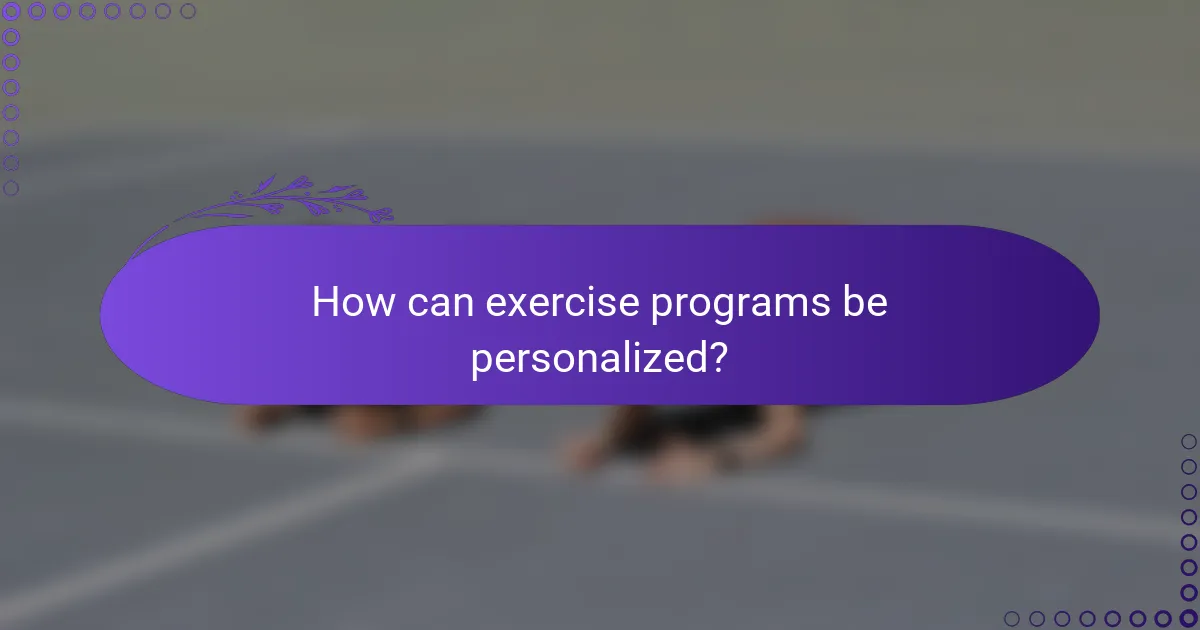Creating an effective exercise program involves personalizing workouts to align with individual goals, fitness levels, and preferences. By combining cardiovascular activities with strength training, these programs not only maximize calorie burn but also support muscle retention. Tailoring exercise routines enhances adherence and effectiveness, making it easier for individuals to reach their desired fitness outcomes.

What are effective exercise programs for weight loss?
Effective exercise programs for weight loss typically combine cardiovascular workouts with strength training to maximize calorie burn and muscle retention. Personalization based on individual goals, fitness levels, and preferences is crucial for sustainability and success.
High-Intensity Interval Training (HIIT)
HIIT involves short bursts of intense exercise followed by brief recovery periods. This method can significantly elevate heart rate and boost metabolism, leading to substantial calorie burn in a shorter time frame compared to traditional workouts.
For beginners, a typical HIIT session might last 20-30 minutes, alternating between 30 seconds of high effort and 1 minute of rest. As fitness improves, you can increase the intensity or duration of the high-effort intervals.
Strength Training
Strength training focuses on building muscle mass, which can enhance metabolism and promote weight loss. Incorporating exercises like squats, deadlifts, and bench presses helps to increase overall strength and improve body composition.
Aim for at least two to three sessions per week, using weights that allow you to perform 8-12 repetitions per set. Gradually increase weights as your strength improves to continue challenging your muscles.
Circuit Training
Circuit training combines strength and cardio exercises into a single workout, performed in a sequence with minimal rest. This approach keeps the heart rate elevated while building strength, making it efficient for weight loss.
A typical circuit may include 5-10 different exercises targeting various muscle groups, completed in a set time frame. Aim for 30-60 seconds per exercise, with a 1-2 minute rest between circuits.
Outdoor Boot Camps
Outdoor boot camps provide a group workout environment that combines cardio and strength training. These sessions often include a variety of exercises, such as running, jumping, and bodyweight movements, designed to challenge participants at all fitness levels.
Joining a local boot camp can offer motivation and accountability, with classes typically lasting 45-60 minutes. Look for programs that emphasize safety and proper technique to prevent injuries.
Yoga for Weight Loss
Yoga can aid in weight loss by promoting mindfulness and reducing stress, which are essential for maintaining a healthy lifestyle. Certain styles, like Vinyasa or Power Yoga, can also provide a cardiovascular workout while improving flexibility and strength.
Incorporate yoga sessions 2-3 times a week, focusing on poses that engage multiple muscle groups. Pairing yoga with other forms of exercise can enhance overall fitness and support weight loss goals.

How can exercise programs be personalized?
Exercise programs can be personalized by tailoring them to individual needs, preferences, and goals. This customization enhances effectiveness and adherence, making it more likely for individuals to achieve their fitness objectives.
Fitness Assessments
Fitness assessments are essential for understanding an individual’s current physical condition. These evaluations typically include measurements of strength, endurance, flexibility, and body composition. By identifying strengths and weaknesses, trainers can design programs that target specific areas for improvement.
Common assessment methods include functional movement screenings, cardiovascular fitness tests, and strength assessments. These tools help set a baseline and track progress over time, ensuring that the exercise program evolves with the individual.
Goal Setting
Setting clear and achievable goals is crucial for a personalized exercise program. Goals should be specific, measurable, attainable, relevant, and time-bound (SMART). For instance, rather than aiming to “get fit,” a more precise goal could be to “run 5 kilometers in under 30 minutes within three months.”
Regularly revisiting and adjusting these goals keeps motivation high and allows for necessary changes based on progress or setbacks. This adaptability is key to maintaining engagement and commitment to the exercise program.
Individual Preferences
Incorporating individual preferences into an exercise program increases enjoyment and adherence. This includes considering the types of activities someone enjoys, whether it’s running, swimming, or group classes. Personal preferences can significantly influence the likelihood of sticking to a routine.
Additionally, factors such as preferred workout times, environments, and social settings should be taken into account. For example, someone might prefer outdoor activities during the day, while another may thrive in a gym setting during the evening.
Health Conditions Consideration
When personalizing exercise programs, it is vital to consider any existing health conditions. Individuals with chronic illnesses or injuries may require modified exercises or specific precautions to ensure safety. Consulting with healthcare providers can help tailor programs that accommodate these needs.
For example, someone with joint issues might benefit from low-impact activities like swimming or cycling, while those with cardiovascular concerns may need to monitor their heart rate closely during workouts. Understanding these conditions allows for a safer and more effective exercise experience.

What are common fitness goals for exercise programs?
Common fitness goals for exercise programs include muscle gain, improved endurance, flexibility enhancement, and weight maintenance. Each goal requires specific training methods and considerations to achieve optimal results.
Muscle Gain
Muscle gain, or hypertrophy, focuses on increasing muscle size through resistance training. This typically involves lifting weights with progressively heavier loads, aiming for a rep range of about 6-12 repetitions per set. Compound exercises like squats and deadlifts are particularly effective.
To maximize muscle growth, ensure adequate protein intake, generally around 1.6-2.2 grams per kilogram of body weight. Additionally, allow for sufficient recovery time between workouts to prevent overtraining.
Improved Endurance
Improved endurance enhances the body’s ability to sustain prolonged physical activity, primarily through cardiovascular training. Activities such as running, cycling, or swimming are effective, with sessions typically lasting 20-60 minutes at moderate to high intensity.
To boost endurance, gradually increase the duration and intensity of workouts. Incorporating interval training can also be beneficial, alternating between high-intensity bursts and lower-intensity recovery periods.
Flexibility Enhancement
Flexibility enhancement aims to improve the range of motion in joints and muscles through stretching exercises. Regular stretching routines, ideally performed 2-3 times a week, can significantly increase flexibility over time.
Incorporate dynamic stretches before workouts and static stretches afterward. Yoga and Pilates are excellent options for enhancing flexibility while also promoting balance and core strength.
Weight Maintenance
Weight maintenance focuses on achieving and sustaining a healthy body weight through a balanced approach of diet and exercise. Regular physical activity, combined with mindful eating, helps prevent weight gain and promotes overall health.
To maintain weight, aim for at least 150 minutes of moderate aerobic activity per week, along with strength training twice a week. Monitoring portion sizes and food choices is essential to ensure caloric intake aligns with energy expenditure.

How does variety impact exercise programs?
Variety in exercise programs is crucial for maintaining engagement and achieving fitness goals. Incorporating different activities can prevent boredom, enhance overall performance, and support continuous improvement.
Prevents Plateaus
Variety helps prevent plateaus, which occur when the body adapts to a specific routine, leading to diminished results. By regularly changing exercises, intensity, or duration, you can challenge your muscles in new ways, stimulating growth and progress.
For instance, if you typically run at a steady pace, incorporating interval training or switching to cycling can provide fresh stimuli. Aim to change your routine every few weeks to keep your body guessing and progressing.
Increases Motivation
Introducing variety into your exercise program can significantly boost motivation. Engaging in different activities keeps workouts exciting and can make it easier to stick to a fitness regimen over time.
Consider trying new classes, sports, or outdoor activities. Setting small, varied goals, like mastering a new skill or completing a different workout each week, can also enhance your enthusiasm and commitment to your fitness journey.
Enhances Skill Development
Variety in exercise not only improves general fitness but also enhances specific skills. Engaging in diverse activities allows you to develop different muscle groups and improve coordination, balance, and agility.
For example, combining strength training with yoga can improve flexibility while building muscle. Focus on integrating complementary activities that target various aspects of fitness to foster well-rounded skill development.


